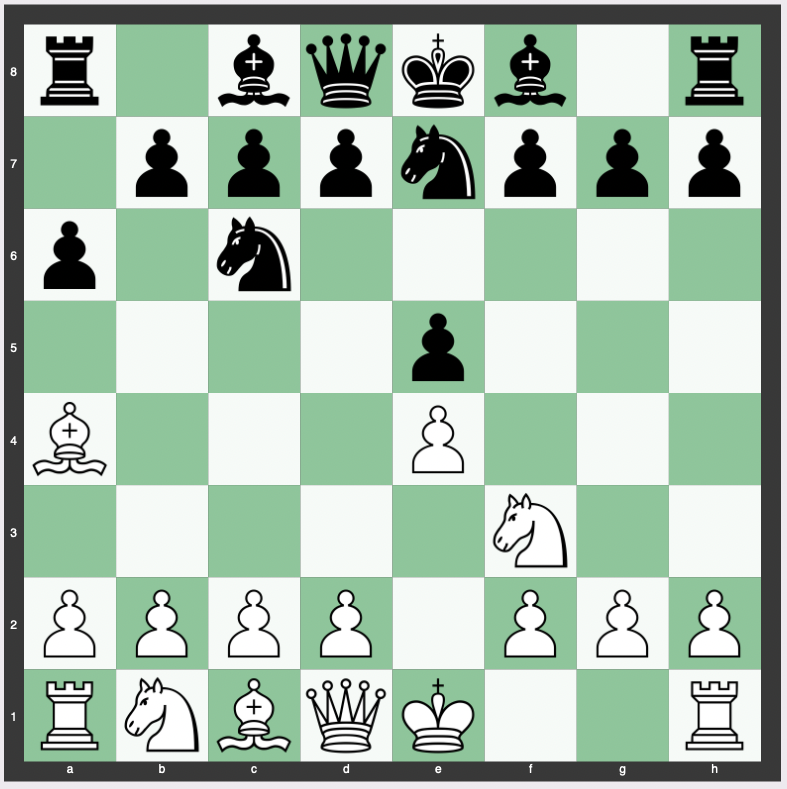Below we look into the Cozio Defense Deferred, a less traditional but creative variant in the Ruy Lopez opening.
Move Order of the Cozio Defense Deferred
The Cozio Defense Deferred follows a distinct sequence of moves:
- e4 e5
- Nf3 Nc6
- Bb5 a6
- Ba4 Nge7

This sequence is characterized by the early development of knights and pawns, with a specific focus on controlling the center of the board.
Notably, Nge7 is the key move that defines this opening as the Cozio Defense Deferred.
Theory, Strategy, and Purpose of the Cozio Defense Deferred
The primary theory behind the Cozio Defense Deferred is to delay the decision of the f8-bishop until white has revealed more about their own development strategy.
In comparison to the usual third move, …a6, the knight move to e7 allows black to keep the option open of playing g6 and Bg7, increasing the bishop’s scope.
Also, the Nge7 maneuver is aimed at limiting White’s options in the center and on the kingside. It puts pressure on White’s center pawn at e4 and prepares for a possible d5 push.
Variations of the Cozio Defense Deferred
Within the Cozio Defense Deferred, there are several interesting variations that a player can explore.
One of the critical variations is 5.0-0 Ng6, which allows black to aim for quick kingside castling once making room for the bishop to develop.
This move may also provide support for an eventual f5 push to challenge white’s pawn on e4.
Another variation is 5.0-0 g6, which prepares the way for the fianchetto of the bishop on g7.
This setup provides a strong control of the center and a solid, although slightly passive, position for black.
ECO C70 Ruy Lopez, Cozio defense deferred (White perspective)
History of the Cozio Defense Deferred
The Cozio Defense Deferred, like its parent Ruy Lopez, traces its roots back to the 16th century.
Named after the Italian chess player, Carlo Cozio, the Cozio Defense and its deferred variant have long been considered offbeat and less explored options within the spectrum of chess openings.
Though not as popular as other Ruy Lopez defenses, it has been employed by several grandmasters throughout history, particularly those who prefer surprise weapons and less charted paths.
Is the Cozio Defense Deferred Good for Beginners or Intermediates?
The Cozio Defense Deferred can be a good option for both beginners and intermediate players.
For beginners, the opening offers a chance to learn about less commonly used structures, strategic ideas, and the importance of flexible piece development.
For intermediate players, this opening provides an avenue to introduce surprise elements in their games and delve into less-explored territories of opening theory.
How Often Is the Cozio Defense Deferred Played at the Grandmaster Level?
While not a mainstream choice, the Cozio Defense Deferred does make occasional appearances at the grandmaster level.
Its sporadic use in high-level chess is largely due to its reputation as a surprise weapon.
Grandmasters often opt for it when they wish to sidestep well-known theoretical battlegrounds of the Ruy Lopez and lead the game into less familiar territory.
It is represented by the ECO Code C70 so it is known by top players and they should prepare for it.
Conclusion
The Cozio Defense Deferred is a unique and interesting path within the Ruy Lopez opening.
Its unconventional approach to piece development and the potential to lead the game into uncharted waters make it an intriguing study for chess enthusiasts of all levels.
While it may not be the first choice for many players, its potential for surprise and strategic depth makes it a worthwhile addition to any chess player’s repertoire.


